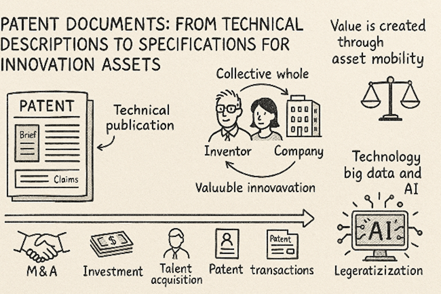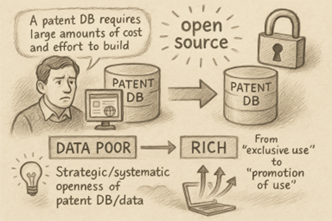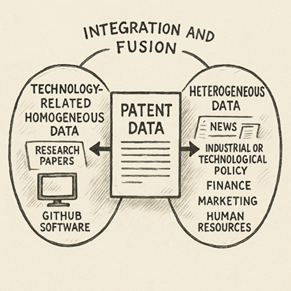Vision.
Welcome to PatentPia Inc.
PatentPia Inc.
Believing in the infinite value and versatility of global patent data as a repository of collective technological intelligence,
we have been delivering services, data solutions, and consulting based on differentiated
big data and AI since our establishment.

MISSION
Address diverse customer and market challenges related to patent data
Pioneer new frontiers in patent data utilization by offering easy-to-use, differentiated, and valuable patent data and services for a wide range of businesses
Accelerate the optimal global reallocation of innovation assets
Develop and implement distinctive business models in collaboration with partners
History
- 2024
Integrated patents, academic papers, and GitHub software data to develop and launch a technology strategy support system (strategy.patentpia.com)
Developed a GPT-based Q&A service powered by LLM technology (patentpiagpt.patentpia.com)
- 2022
Developed a patent big data construction and utilization service (goldencompass.patentpia.com)
- 2016
Launched an AI model and service (www.patentpia.com) for predicting promising technologies
- 2010
Developed an AI model and system for predicting highly litigious patents
- 2008
Developed a patent evaluation model applying machine learning techniques to patent data
- 2002
Company founded
What
we're doing
- Operating PatentPia web service
- Supplying patented big data and AI solutions
- Providing consulting services based on patented big data
Vision and Strategic Outlook on Patents
For over 20 years, PatentPia Inc. has been dedicated to the patent industry, guided by the following vision and strategic outlook.
The technology, data, services, and future strategy of PatentPia Inc. are grounded in the following vision and strategic outlook.
While this perspective did not emerge overnight, it has been shaped and refined over the past 20 years.
The Nature of Patent Rights: From Exclusivity to Utilization

Historically, the patent system has been centered on the principle of exclusive use.
However, the environment in which technology is applied is undergoing fundamental change—with rapidly shifting market demands, shorter technology lifecycles, increasing product and service diversification, and the widespread adoption of AI. As a result, it is time for technology, like copyrighted material, to evolve toward broader global accessibility.
Innovation assets—such as patent rights, the technologies themselves, the companies that own them, and the inventors behind them—must shift from an "exclusivity-focused" model to one that promotes active utilization. Only through this transition can the efficiency and market value of innovation assets be fully realized.
New data, AI technologies, business models, and services must emerge to globally accelerate the “utilization” of innovation assets.
PatentPia hasn't even made it past Chapter One—it's still in the prologue. Yet even at this early stage, it seeks to demonstrate how patent big data can be leveraged to promote the effective utilization of these assets Link →
Patent documents: From Technical Descriptions to Specifications for Innovation Assets

A patent document typically consists of a brief bibliography, a description of the invented technology, and claims defining legal rights. Because of this structure, patent documents have historically been viewed as a type of technical publication—an extension of academic papers. This widespread misconception has fundamentally limited the recognition of their true value and utility.
Patent documents should not be treated as isolated records, but rather as part of a collective whole. When viewed this way, not only the technology described in the patent, but also the companies that own the patents, the inventors behind them, the underlying technology, the professionals working with them, and the patents themselves can all be considered valuable innovation assets.
In a capitalist economy, value is created through the movement, combination, and optimal reallocation of assets. In this context, asset mobility is the core driver of value creation.
Technological innovation assets are mobilized through M&A and investment, talent acquisition, patent transactions and licensing, and more. To accelerate and optimize this process, technology big data and AI must be leveraged to discover and enable the fluid movement of these innovation assets.
Patent DB/Data : From Ownership to Openness and Open Dataization

Patent databases are high-end systems that require significant investment in construction, maintenance, and quality control. Due to these high costs, most patent DB providers do not truly open their data—instead, they simply offer limited access through web-based UI/UX services. This approach reflects the paradigm of the data-poor era, and may no longer be appropriate in today’s data-rich environment.
The innovation and value that the open-source movement has brought to the software world is immeasurable. Patent DBs and data represent another class of critical assets that would greatly benefit from the open-source ethos. Fortunately, the exponential growth in computing power now provides a foundational infrastructure that makes the open-sourcing of patent databases and data increasingly feasible.
A strategic and systematic move toward opening, or at least increasing the openness, of patent DBs and data aligns with the broader shift in the nature of patents—from a model centered on exclusive use to one focused on enabling utilization.
Patent business: From Standalone to Integration and Fusion with Homogeneous and Heterogeneous Data

Patent data, when used in isolation (stand-alone), cannot fully unlock its value. The full potential of patent data is realized when it is connected or combined with homogeneous or heterogeneous data. This type of integration and fusion is, in many ways, an inevitable choice in the era of data abundance.
First and foremost, patent data should be integrated with and fused with technology-related data, such as research papers and GitHub software data. Together, patents, papers, and software constitute the vast majority of technology data.
Furthermore, patent data should also be linked and fused with heterogeneous data such as news, - industrial or technological policy, finance, marketing, and human resources.
The points of intersection for connecting heterogeneous data include 1) organizations, 2) individuals, 3) representations or expressions, and 4) identifiers such as numbers. Ensuring the reliability of these intersections is not easy for any single organization to achieve alone. AI and large language models (LLMs) will be crucial tools in securing the reliability of these connections.
At the intersections where patent data and heterogeneous data are integrated and fused, new, small, and temporarily exclusive businesses can be created.



